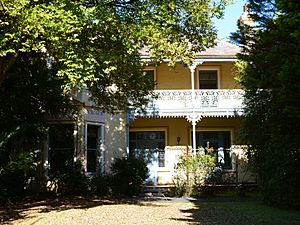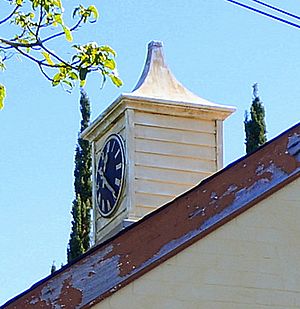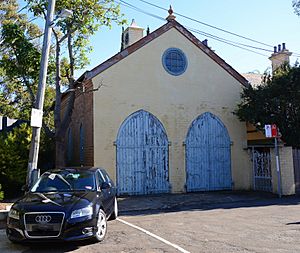Tarella (Cammeray) facts for kids
Tarella is a special old building located at 3 Amherst Street in Cammeray, New South Wales, Australia. It was built a long time ago, between 1874 and 1886. Today, it's not just a home but also a place where businesses operate. This historic site is so important that it was added to the New South Wales State Heritage Register on April 2, 1999, which means it's officially protected for future generations.
Quick facts for kids Tarella |
|
|---|---|

Tarella, pictured in 2015.
|
|
| Location | 3 Amherst Street, Cammeray, North Sydney Council, New South Wales, Australia |
| Built | 1874–1886 |
| Built for | Sir Joseph Palmer Abbott KCMG |
| Architectural style(s) | Victorian Italianate |
| Official name: Tarella | |
| Type | State heritage (built) |
| Designated | 2 April 1999 |
| Reference no. | 270 |
| Type | House |
| Category | Residential buildings (private) |
| Lua error in Module:Location_map at line 420: attempt to index field 'wikibase' (a nil value). | |
Contents
Tarella: A Historic Home in Cammeray
The street where Tarella is located, Amherst Street, is named after Lord William Pitt Amherst. He was a very important leader in India, serving as the Governor-General of India from 1823 to 1828.
Who Lived at Tarella?
Tarella was originally the home of Sir Joseph Palmer Abbott. He was a significant politician in New South Wales. From 1880 to 1900, he was the Speaker of the New South Wales Legislative Assembly. This means he was in charge of running meetings in the state's parliament.
Sir Joseph Palmer Abbott built Tarella around 1886. He had bought the land for it in 1881. He was also involved in creating the rules for the Commonwealth of Australia. He helped shape the country's first Constitution in 1891 and again from 1897 to 1898. A nearby street in Cammeray, Palmer Street, is named after him.
Saving Tarella: A Heritage Story
In the early 1970s, Tarella was beautifully restored. It was filled with furniture and decorations that matched its historical period. The house has lovely coloured glass windows and detailed iron lace decorations. Its front lawns and garden feature a fountain and iron gates. These gates were moved here from the historic St John's Anglican Church in Parramatta.
In 1982, the owner, John Hawkins, wanted to change the rules for the property. He hoped to use Tarella as offices for architects. Mr. Hawkins had worked hard to restore the house. He wanted to make sure it would be kept safe and used. However, the local council was worried about losing residential areas. They did not want to change the rules.
The Heritage Council, a group that protects important places, looked at the situation. They understood the council's concerns. But they also believed Tarella was too important to lose. They decided to support ideas that would keep the building safe and well-maintained. They also warned that if anyone tried to demolish Tarella, they would recommend protecting it under the NSW Heritage Act. This law helps save historic buildings.
In 2001, a company bought the property. Later, a childcare company proposed to open a centre for 80 children at Tarella. This would mean the building would be used five days a week. At first, the local council and the Heritage Council said no. They were concerned about how it would affect the historic building and its surroundings. However, after an appeal to the Land and Environment Court of New South Wales, the childcare centre was approved.
What Does Tarella Look Like?
Tarella is a grand and impressive house. It is set far back from the street, on a large piece of land. A winding driveway leads through a big lawn, surrounded by trees and shrubs.
The Gardens at Tarella
Between the street fence and the house, there is a large, somewhat formal garden. It features two tall Canary Island date palms and Alexandra palms. You can also see Himalayan cedar trees, lavender hedges, roses, pomegranate trees, and frangipani trees. There is a fountain and a pond in the lawn. An old photograph from 1899 does not show the Canary Island date palms. This suggests they were planted in the early 1900s.
Inside the House
Tarella is a two-storey house built in the Victorian Italianate style. This means it has features inspired by Italian Renaissance architecture. It is made of brick, which is now painted. The roof is made of slate tiles and has a hipped shape, meaning it slopes on all four sides.
The front of the house has a two-storey verandah. The lower part of the verandah has patterned tiles in a mosaic design. Thin cast-iron columns support the upper level. The front door is made of panels and has glass panels on the sides and above it.
Inside, many original features are still there. These include a grand wooden staircase and a main entrance area. There is a large stained glass window near the stair landing. The house also has 13 marble fireplaces. The plaster ceilings are mostly untouched.
Other Buildings
Behind the main house, there is a two-storey stable building. It was built more recently by Mr. J. Hawkins. It has a style that matches the old house, with double pointed arch doorways. This building faces a laneway.
Condition and Modifications
As of 2016, Tarella is beautifully restored and in excellent condition. Both the outside and inside are well-maintained and look like they did in the past. The stable building was added more recently. Some small changes have been made to minor rooms at the back of the house.
Why is Tarella Important?
Tarella is listed on the New South Wales State Heritage Register because it is a very important historical site. It was the home of a significant public figure from the 1800s, Sir Joseph Palmer Abbott. It is also one of the oldest buildings still standing in the area. Its excellent condition and preserved original features make it a valuable example of Victorian-era architecture.



